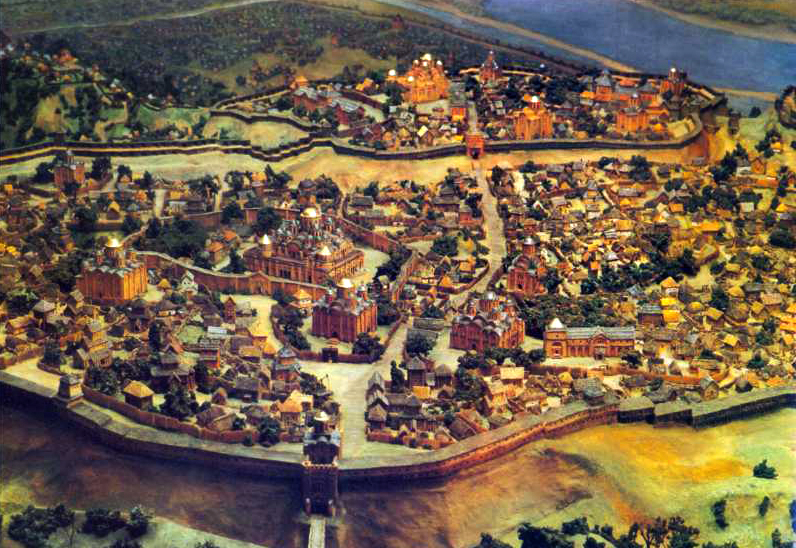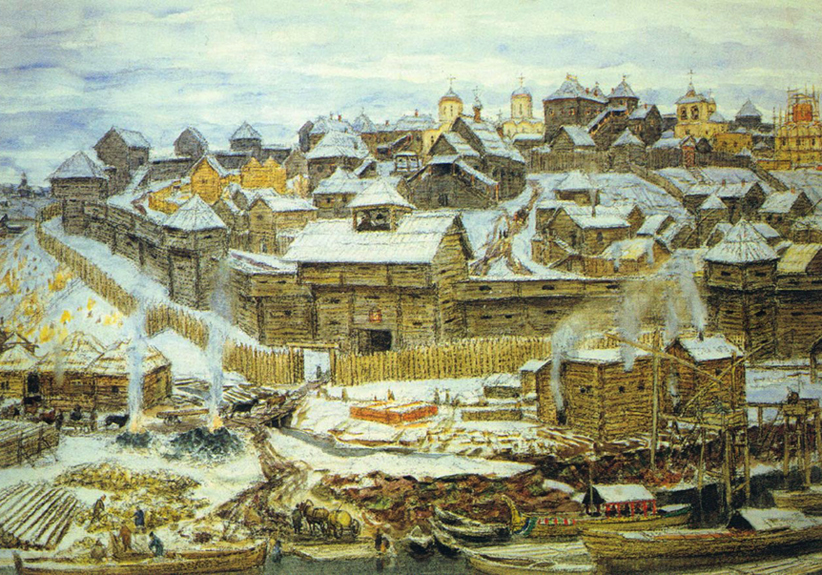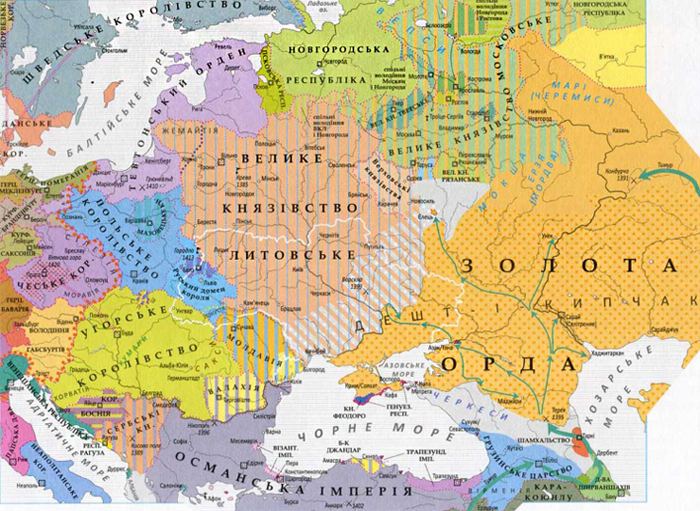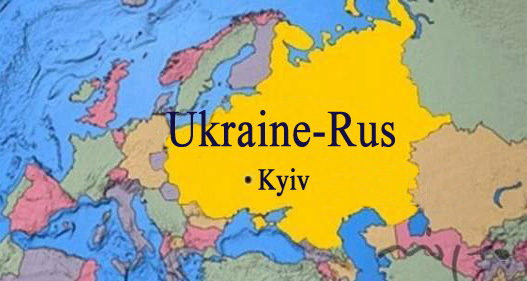Photo. Ukraine-Rus// https://reporter.zt.ua/2018/11/rus-ukraina-otrymala-vid-
moskovii-zamist-vdiachnosti-za-vykorystannia-svoho-imeni-sanktsii/
Stereotype 4. The name “Ukraine” means “okraina” (the outskirts) of the Russian country.
This stereotype was coining in the 19th century, the period of time when the Ukrainian lands were occupied by the Russian Empire. They applied the similarity of the name “Ukraine” and the Russian word “okraina” (meaning outskirts). Geographically located to the West and to the South of the central part of the Russian Empire, the Ukrainian lands really seemed to be at the outskirts of it after the occupation. The fact was employed with the purpose to manifest the inferiority of the Ukrainian state awareness on the background of the “glorious” Russia!
During the times of Rzeczpospolita, the lands of the Southern Kyivshchyna, East Podillia and Zaporizhzhia were bordering on the Tatar lands and were called Ukraine while those of Volyn, Halytsia (Galicia), the Northern Kyivshchyna were called Rus. The Polish, however, did not see any ideological background in the name of Ukraine.
The written sources in which the name of “Ukraine” first appear are dated much earlier than the written evidences with the name of “Russia”. Thus, the Rus (Ruthenian) chronicle (Litopys) dated 1187 mentions Ukraine in connection with the death of the ruler of the Pereiaslav Principality, Volodymyr Hlibovych who was “mourned greatly by all of Ukraine”. The city of Pereiaslav did not belong to the outskirts of Rus (Ruthenia). In this case, Ukraine was mentioned as the territory possessed by the Prince (Ukraine as vidkraianyi that is the land cut off and given into possession).
In the 16th-17th centuries, the name of Ukraine was applied for most of the former lands of Rus (Ruthenia). For instance, in 1602, Cossack hetman (leader) Ivan Kutsevych outlined the territory from Polissia (Polissya) to the Black Sea: “Starting from Mohyliv, all the Ukraine and up to the Dnipro River mouth, all this is our prystavstvos (territorial units)”.
Moreover, within the European countries, the idea of Ukraine as the territory inhabited by the Ukrainians started to spread at the end of the 17th century due to the work of Guillaume Levasseur de Beauplan (Description d’Ukranie, 1652).
In the 18th century, Pylyp Orlyk, who was fighting for the restoration of the Ukrainian statehood, strove to become the hetman of indivisible Ukraine. At that time, Ukraine coincided with the notion of Hetmanate.
Further, in the 19th century, the new Ukrainian nobility applied the name of Ukraine as the locally used name for all the Ukrainian lands and revived the traditions of Hetmanate nobility. Eventually, the territory of the contemporary Ukraine has been bearing the name of Ukraine since the 12th century. This name had been used along with the name of Rus (Ruthenia) far long before the Russian state appeared in the world’s map.
Stereotype 5. Russia is the sole heir of Rus (Ruthenia) but not Ukraine
If you follow this stereotype, the Russian Federation is the apparent heir of all the heritage belonging to the medieval state called Rus (Ruthenia) with the centre in Kyiv (Kiev). At the end of the 15th century, the theory of dynasty was formulated to claim that the Moscow (Muscovy) princes as the heirs of the Russian Dynasty of Rurik could have the right for the Kyiv heritage, that is the land which had been once a part of the Rus (Ruthenia) of the Kievan Rus. In the second half of the 16th century, this theory was enhanced by the concept of “Moscow – the next Kiev”.
During the 18th-19th centuries, the new scheme of the Russian history has been developed. According to it, the state of Rus (Ruthenia), which started to be called the Kievan Rus, continued its existence as so-called Vladimir-Suzdal Rus, later called Muscovy Rus which became the Russian Empire in 1721. This scheme is anti-scientific by its essence as grounded on the ideology and manipulations and obvious propaganda.
The core of the Rus (Ruthenia) state was formed at the lands of the Slavic tribes of the Poliany (the Polianians), the Siverianians (the Severians), the Derevlianians and others on the territory of the contemporary Kyivshchyna, Chernihivshchyna, Podillia (Podolia), Volhynia, Prykarpattia (Trans-Carpathis). This fact is impossible to deny, however, M. Pogodin, the historian from Moscow, claimed the strange theory in 1830 on the relocation of the Russians from Kyivshchyna into Muscovite lands as the consequences of the Mongol conquest. This theory was defeated in the 19th century by M. Maksymovych and V. Antonovych, the Ukrainian historians.
The Russian ethnos and further the Russian state were being shaped between the Volga River and Oka between the 11th-13th centuries, where lived the Finno-Ugric tribes of the Merya, the Muroma, the Erzya and others. These territories actually were included into the Rus (Ruthenia) in the 10th-11th centuries as the result of the military activities of Sviatoslav the Brave, Volodymyr the Great, and Yaroslav the Wise. A long time, these land were being called Zalissia (the lands behind the forest).
After the Mongol invasion, the Muscovite princes and later the tsars from Ivan III were not much concerned with the history of the Kyiv period and did not claim for the Kyiv heritage. Moreover, during the second half of the 13th-15th century, the Principality of Moscow was a part of the Mongol Empire and its princes were assigned for ruling by the Mongol khans. Even the coat of arms of the Muscovy state was apparently different from the Trident (Tryzub) of the Kyiv Princes and was considered strange to Muscovite or Russian rulers.


Meanwhile the lands that had been incorporated into the Halytsian-Volynian (Galicia-Volhynia) Principality by the middle of the 14th century were called the Kingdom of Rus (Ruthenia) headed by the elder branch of Rurik dynasty, namely the kings of Danylo, Lev, Jurii.
The Rus Princes who lived at the times of the Magnus Ducatus Lithvaniae, Rusiae, etc. were followed by the new Cossack nobility in continuing the traditions of the medieval state called the Kievan Rus. In particular, Theodosius Sophonovych, the hegumen of Kyiv Golden-Domed Monastery, writes in his chronicles dated 1672 about the direct line between the rulers of the Princes’ period and the epoch of Hetmanate and the Zaporozhian Host.
Before the 19th century, the people in Europe used to attribute the name of Rus (Ruthenia) to the territory of the Ukrainian lands while in the 20th century, they called the inhabitants of Halytsia (Galicia), Zakarpattia, and Bukovyna as the Rusyns or the Ruthenians.
Eventually, the contemporary Ukraine is the heir of the statist and political, the social and economic, the historic and cultural traditions of Rus (Ruthenia). Therefore, the existence of independent Ukraine is itself a significant challenge for the right of the Russian Federation to be solo attributed to the Rus-Ukrainian history, to the Rus-Ukrainian princes, to the Rus-Ukrainian culture as well as is a continuous reminding for the Russians of their falsification with both the own history and the history of Ukraine.
Stereotype 6. “Rus is the Ancient Name of Russia”. Trying to please their rulers, the Russian historians have been developing and producing the scheme since the 18th century, in which the Old Ukrainian state of Rus (Ruthenia) is claimed to develop into Russia and all the princes of Rus are claimed to be the Russian leaders.
They actively appeal to the similarity in the names of Rus and Russia, the Rusyns and the Russian. The Greek name of Rus has been known from the 15th century and is Ρωσία. This name has been manipulated and employed for the certain purposes by the Muscovite tsars, later by the imperators and currently by the presidents. All these manipulations have always been only for manifesting the scope of the own territorial claims for the Ukrainian and the Belarusian lands. The contemporary name of Russia was deliberately transferred into the setting of the 11th – 17th century though during that period the Roman Empire (Byzantium) and the whole Europe attributed the name of Rus (Ruthenia) not to the state with the capital in Moscow but to the Ukrainian territories and partly to the Belarusian lands.
The lands of Kyivshchyna, Chernihivshchyna, Podillia, Halytsia, Volhynia were referred as those which were beyond the borders of Muscovy. When the Crown of the Polish Kingdom took the control over the Ukrainian lands in the 14th century, Halytsia was called as Województwo Ruskie (the Ruthenian Voivodeship). In the 15th century, much of the Ukrainian lands appeared under the control of the Grand Duke of Lithuania, the united country acquired the name of Magnus Ducatus Lithvaniae, Rusiae, etc. During concluding the Ugoda Hadziacka (the Treaty of Hadiach) in 1658 between Rzeczpospolita and the Zaporozhian Host, there was planned the establishment of the three nations’ commonwealth among which the Grand Ruthenian Principality was to be formed.
The name of Russia came into use in the middle of the 15th century. In 1547, Ivan IV was crowned to reign the tsardom which had the pretentious name of the Tsardom of Russia. After the Pereiaslav Rada or Pereiaslav Agreement (also spelled as Pereyaslav or PerejasŁaw) and signing March Articles in 1654, when the Ukrainian lands were submitted to the Russian rule, Alexey Mikhaylovich (also known as Alexis) became “the Autocrat of Great and Minor and Bela Russia”. However, it was not until the 18th century when the name of Russia was widely used. Ironically, the one who inspired renaming Muscovy Tsardom into the Russian Empire in 1721 was the Ukrainian Orthodox theologian and philosopher Feofan Prokopovych. It was he who developed the concept of Russia as the Motherland for all who are the subjects of the tsar.

The derivatives of Rus-Ukraine are the notions of “Russian” and “the Russian land” while the inhabitants of Rus were called the Rusyns or the Ruthenian (from Latin Rutheni). In Muscovy, they started to operate the term of “Russian” and the inhabitants acquired the name of the Russians. That is how two names have been interchanged. For instance: “Volodymyr is the prince of Rus” sounds in the version of Russia as “Vladimir is the Russian prince”.
The Ukrainian historian Ya. Dashkevych noted, “Muscovy actually have seized the name of Rus, which in its essence – ethnically, geographically, structurally – properly corresponds to the contemporary name of Ukraine. … This allowed Muscovy to obtain a kind of pride, a fraud one but pride of the cultural and civilized state with the long history and the birth certificate issued by the Byzantine-Kievan Church”. Finally, the last 300 years when the Ukrainian lands were occupied by the Muscovites, the conquerors not only appropriated or robbed of, the lands but also history and even the name of our state.
The current article relies on the open source information and quotes the book by V. Brekhunenko (Брехуненко В. Війна за свідомість. Російські міфи про Україну та її минуле.‒ К., 2017 ‒ 280 с.)
Our advice to read:
Білінський В.Б. Україна-Русь: історичне дослідження: у 3-х кн. Кн. 1. Споконвічна земля.– Тернопіль: Навчальна книга-Богдан, 2018.– 384 с.: іл.
Гаврилів І. Україна – Росія: протиборство европейської та евразійської цивілізацій.– Львів: Левада, 2018.– 107 с.: 3 л. карт.
Галушко К. Україна на карті Європи: Україна та українці у картографії від Античності до ХХ століття: наук.-популярне видання.– Київ, 2013.– 143 с.
Народження країни. Від краю до держави. Назва, символіка, територія і кордони України.– Харків: Клуб сімейного дозвілля, 2017.– 352 с.: карти.– (Історія без цензури).
Семененко В.І. Хто такі українці? Що таке Україна?.– Харків: Школа, 2010.– 160 с.– (Історичний архів. Маленькі таємниці великої історії).











